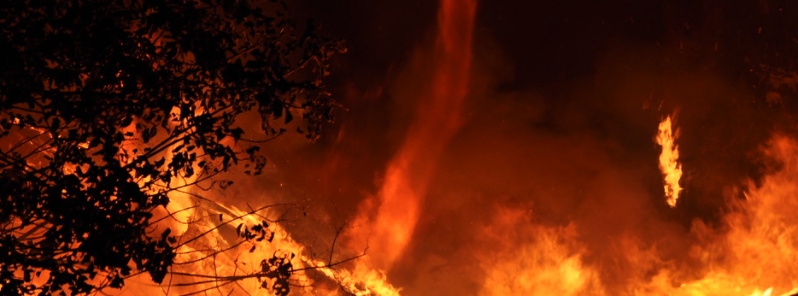Creek Fire becomes largest single blaze in California, spawning 2 rare fire tornadoes

The Creek Fire in California has become the state's largest single blaze record, scorching up to 117 935 ha (291 426 acres) of land as of Thursday, September 24, 2020, and is only 34 percent contained. The blazes spawned two rare tornadoes rated EF-1 and EF-2 a day after the fire started earlier this month, the National Weather Service (NWS) confirmed.
The blaze started on September 4, near Mammoth Pool, Shaver Lake, Big Creek, and Huntington Lake. In a span of just three weeks, the flame exploded to 117 935 ha (291 426 acres), left nearly 1 000 structures damaged or destroyed, and is posing threats to 6 723 more properties.
Around 3 085 fire personnel have been deployed to combat the flame, with the full containment expected to be accomplished by October 15.
As of Thursday, September 24, the Creek Fire has become the largest single blaze in the history of California as the state is experiencing its worst fire year since the 1910 Great Fire, which ripped through more than 1.2 million ha (3 million acres) of land.
On Wednesday, NWS confirmed that in a rare event, the blaze spawned two fire tornadoes or firenadoes on September 5, a day after it sparked. One was rated EF-2 with winds up to 201 km/h (125 mph) and the other EF-1 with winds of up to 160 km/h (100 mph).
CNN meteorologist Taylor Ward noted that to have even one tornado within a fire is rare. "Fires can lead to fire whirls– kind of like a dust devil– due to differential heating, but to get a tornado with winds over 160 km/h (100 mph) is quite unusual."
One of the firenadoes occurred in Mammoth Pool Reservoir in the Sierra National Forest well southeast of Yosemite, while the other formed near Bass Lake.
Today the @NWS confirmed the Creek Fire plume (9/5) contained an EF-1 & an EF-2 tornado.
Seriously wild fire behavior. pic.twitter.com/ij370gCKWg
— Dakota Smith (@weatherdak) September 25, 2020
#CreekFire is the largest single fire in in California state history (>289k acres burned) 34% contained;this video released from City of Merced Fire Department shows them doing all they could before being forced to retreat. This weekend wind & low humidities are back-not good. pic.twitter.com/oKyJadzsck
— Ginger Zee (@Ginger_Zee) September 24, 2020
WALL OF FLAMES: Newly released helmet camera video shows California firefighters rushing into a neighborhood threatened by the Creek Fire. https://t.co/e2rOSm2LmT pic.twitter.com/d55D5Bb9tH
— ABC News (@ABC) September 17, 2020

Unlike firewhirls, which is usually seen forming from the ground up over small brushfires, fire tornadoes are actual tornadoes but are dynamically different than normal ones in general.
This phenomenon is produced by rotating clouds or smoke plumes in environments where wind change and direction with height. While the funnels are not filled with fire literally, they are filled with a superheated column of debris, ash, and smoke.
The historic wildfires in the state have generated intense heat, causing the vortices to develop, according to NWS meteorologist Jerald Meadows.
"The main contributing factor was the debarking of all the pine trees up with the Mammoth Pool tornado," he explained.
"They both uprooted trees to the root balls and snapped large pines. But the [EF1 tornado] did not have any signs of true debarking. We’re probably talking the difference between 160 and 177 km/h (100 and 110 mph)."
Meadows added that a tornado warning was considered, but was not issued. "A tornado warning for a fire opens up a can of worms."
"We want to make sure we’re messaging properly, and we were talking to fire crews letting them know of the circulations we were seeing," he added, as issuing such an alert may leave residents unnecessarily conflicted about deciding whether to evacuate or take shelter.
"We need to get the science down before we start building policy about when we alert the public about such things. We don’t want to overburden emergency services or the public with limited science."
It was not the first time this year that such a phenomenon occurred– the Loyalton Fire in Northern California also spawned one firenado in August.
And here is a side view at ~2100 UTC on Sept. 5th, showing plume tops at ~16.5 km (~55Kft). Totally insane. #PyroCb #CreekFire #pleaseRAIN #CAwx #CAfire pic.twitter.com/90mCiiBYh7
— Neil Lareau (@nplareau) September 9, 2020
NWS storm surveys confirmed that the #CreekFire produced two fire tornadoes on Sept 5th, 2020. The first tornado just north of Mammoth Pool produced winds up to 125 mph (EF2) and the second near Huntington Lake produced winds up to 107 mph (EF1). @USTornadoes @Weather_West #CAwx pic.twitter.com/O2mfNM0lnB
— US StormWatch (@GreatWinter2017) September 23, 2020
I took pictures in the area of the Creek Fire. It’s less than an hour away from Fresno. The fire brought our area international attention. pic.twitter.com/qyx4M1XjAr
— Peter Maiden (@PeterDMaiden) September 23, 2020


Featured image credit: Lisa Donahoo/Flickr

” fire tornadoes are actual tornadoes but are dynamically different than normal ones in general.”
You might add the “fire tornadoes” did not exist until the USAF created them as part of their “Owning the Weather by 2025” program.
Sharknado 17 – This time they’re on FIRE!
The Creek fire is NOT the largest blaze in California history, the August Complex is, and is curently at 867,000 acres and 43% contained.
‘single blaze’